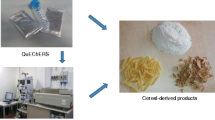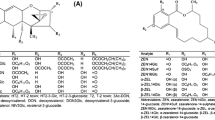Abstract
This study was designed to determine the residual trichothecene mycotoxins in cereal samples. The optimal solvent for extraction was 84% (v/v) aqueous acetonitrile with 1% (v/v) formic acid. The best performing clean-up method was dispersive-solid phase with a mixture octadecyl silica and primary-secondary amine. The recoveries for the studied mycotoxins ranged from 83.3 to 92.8%. The methodology was successfully applied for monitoring 100 cereal samples obtained from a Korean market. The bean sample were found to be co-contamination with deoxynivalenol and HT-2 toxin. Deoxynivalenol possessed the highest detection freauency (4/100) and amount (727.38 µg/kg) among the trichothecene mycotoxins. The hazard index was less than 1.0 for all the observed mycotoxins in all cereal samples except one white rice sample (1.2681). This results indicated that periodic risk assessments of trichothecene mycotoxin through cereal intake are necessary for the health and safety.


Similar content being viewed by others
References
Abramović BF, Jajić IM, Jurić VB, Gaál FF. Optimization of the determination of deoxynivalenol in corn samples by liquid chromatography and a comparison of two clean-up principles. Journal of the Serbian Chemical Society. 70: 1005-1013 (2005)
Adebo OA, Molelekoa T, Makhuvele R, Adebiyi JA, Oyedeji AB, Gbashi S, Adefisoye MA, Ogundele OM, Njobeh PB. A review on novel nonthermal food processing techniques for mycotoxin reduction. International Journal of Food Science and Technology. 56: 13-27. (2021)
Agriopoulou S, Stamatelopoulou E, Varzakas T. Advances in occurrence, importance, and mycotoxin control strategies: Prevention and detoxification in foods. Foods. 9: 137 (2020)
Arroyo-Manzanares N, Huertas-Pérez JF, Gámiz-Gracia L, García-Campaña AM. Simple and efficient methodology to determine mycotoxins in cereal syrups. Food Chemistry. 177: 274-279 (2015)
Azaiez I, Giusti F, Sagratini G, Mañes J, Fernández-Franzón M. Multi-mycotoxins analysis in dried fruit by LC/MS/MS and a modified QuEChERS procedure. Food Analytical Methods. 7: 935-945 (2014)
Battilani P, Toscano P, Van der Fels-Klerx H, Moretti A, Leggieri MC, Brera C, Rortais A, Goumperis T, Robinson T. Aflatoxin B1 contamination in maize in Europe increases due to climate change. Scientific Reports. 6: 24328 (2016)
EFSA, European Food Safety Authority Panel on Contaminants in the Food Chain (CONTAM) EFSA scientific opinion on the risks for animal and public health related to the presence of T‐2 and HT‐2 toxin in food and feed. EFSA Journal. 9: 2481 (2011)
EFSA, European Food Safety Authority Panel on Contaminants in the Food Chain (CONTAM). EFSA scientific opinion on the risks to human and animal health related to the presence of deoxynivalenol and its acetylated and modified forms in food and feed. EFSA Journal. 15: e04718 (2017)
EFSA, European Food Safety Authority Panel on Contaminants in the Food Chain (CONTAM) EFSA scientific opinion on the risks to human and animal health related to the presence of 4, 15‐diacetoxyscirpenol in food and feed. EFSA Journal. 16: e05367 (2018)
European Commission. Commission Regulation (EC) No. 856/2005 of 6 June 2005 amending Regulation (EC) No. 466/2001 as regards Fusarium toxins. Official Journal of the European Union L143: 3-8 (2005)
Food and Agriculture Organization of the United Nations (FAO). Worldwide regulations for mycotoxins in food and feed in 2003. FAO Food and Nutrition Paper. 81:165 FAO, Rome, Italy (2004)
Feron VJ, van Vliet PW, Notten WR. Exposure to combinations of substances: A system for assessing health risks. Environmental Toxicology and Pharmacology. 18: 215-222 (2004)
Friend D, Trenholm H, Hartin K, Panich P, Thompson B, Boermans H. Toxicity of T-2 toxin and its interaction with deoxynivalenol when fed to young pigs. Canadian Journal of Animal Science. 72: 703-711 (1992)
ICH, I. Q2 (R1): Validation of analytical procedures: text and methodology. Paper presented at the International Conference on Harmonization, Geneva (2005)
Iha M, Mini C, Okada I, de Cássia Briganti R, Trucksess M. The use of regenerated immunoaffinity columns for aflatoxins B1, B2, G1 and G2 in peanut confection. Journal of Chromatography A. 1483: 1-7 (2017)
Karlovsky P, Suman M, Berthiller F, De Meester J, Eisenbrand G, Perrin I, Oswald IPm Speijers G, Chiodini A, Recker T, Dussort P. Impact of food processing and detoxification treatments on mycotoxin contamination. Mycotoxin Research. 32: 179-205 (2016)
Kim S, Lee S, Nam T-G, Seo D, Yoo M. Comparison of a newly developed liquid chromatography with tandem mass spectrometry method and enzyme-linked immunosorbent assay for detection of multiple mycotoxins in Red pepper powder. Journal of Food Protection. 80: 1347-1354 (2017)
Khayoon W, Saad B, Yan C, Hashim N, Ali A, Salleh M, Salleh B. Determination of aflatoxins in animal feeds by HPLC with multifunctional column clean-up. Food Chemistry. 118: 882-886 (2010)
KHIDI—Korea Health Industry Statistics System The national nutrition statistics. Available from:https://www.khidi.or.kr/kps/dhraStat/result1?menuId=MENU01652&year=2018. Accessed Oct. 31, 2021.
KOSIS—Korean Statistical Information Service Estimated population by weight. Statistics Korea Available from: National Health Measurement Statistics by Weight. Statistics Korea. Available from: https://kosis.kr/statHtml/statHtml.do?orgId=113&tblId=DT_ 113_STBL_1020278&vw_cd=MT_ZTITLE&list_id=113_11304_009&seqNo=&lang_mode=ko&language=kor&obj_var_id=&itm_id=&conn_path=MT_ZTITLE. Accessed Oct. 31, 2021.
Lanza A, da Silva RC, dos Santos ID, Pizzutti IR, Cence K, Cansian RL, Zeni J, Valduga E. Mycotoxins’ evaluation in wheat flours used in Brazilian bakeries. Food Science and Biotechnology. 28: 931-937 (2019)
Lee J-G, Lee Y, Kim CS, Han SB. Codex Alimentarius commission on ensuring food safety and promoting fair trade: harmonization of standards between Korea and codex. Food Science and Biotechnology. 30: 1151-1170 (2021)
Mishra S, Ansari KM, Dwivedi PD, Pandey HP, Das M. Occurrence of deoxynivalenol in cereals and exposure risk assessment in Indian population. Food Control. 30: 549-555 (2013)
Moreira GM, Nicolli CP, Gomes LB, Ogoshi C, Scheuermann KK, Silva-Lobo VL, Schurt DA, Riteni A, Moretti A, Pfenning LH, Del Ponte EM. Nationwide survey reveals high diversity of Fusarium species and related mycotoxins in Brazilian rice: 2014 and 2015 harvests. Food Control. 113: 107171 (2020)
Ostry V, Dofkova M, Blahova J, Malir F, Kavrik R, Rehurkova I, Ruprich J. Dietary exposure assessment of sum deoxynivalenol forms, sum T-2/HT-2 toxins and zearalenone from cereal-based foods and beer. Food and Chemical Toxicology. 139: 111280 (2020)
Rahmani A, Jinap S, Soleimany F. Qualitative and quantitative analysis of mycotoxins. Comprehensive Reviews in Food Science and Food Safety. 8: 202-251 (2009)
Reffstrup TK, Larsen JC, Meyer O. Risk assessment of mixtures of pesticides. Current approaches and future strategies. Regulatory Toxicology and Pharmacology. 56: 174-192 (2010)
Tang EN, Ndindeng SA, Bigoga J, Traore K, Silue D, Futakuchi K. Mycotoxin concentrations in rice from three climatic locations in Africa as affected by grain quality, production site, and storage duration. Food Science and Nutrition. 7: 1274–1287 (2019)
Wen J, Mu P, Deng Y. Mycotoxins: Cytotoxicity and biotransformation in animal cells. Toxicology Research. 5: 377-387 (2016)
Wu Q, Dohnal V, Kuca K, Yuan Z. Trichothecenes: Structure-toxic activity relationships. Current Drug Metabolism. 14: 641-660 (2013)
Ye J, Wu Y, Guo Q, Lu M, Wang S, Xin Y, Xie G, Zhang Y, Mariappan M, Wang S. Development and interlaboratory study of a liquid chromatography tandem mass spectrometric methodfor the determination of multiple mycotoxins in cereals using stable isotope dilution. Journal of AOAC International. 101: 667-676 (2018)
Zhou W, Yang S, Wang PG. Matrix effects and application of matrix effect factor. Bioanalysis. 9: 1839-1844 (2017)
Zhou J, Xu JJ, Cong JM, Cai ZX, Zhang JS, Wang JL, Ren YP. Optimization for quick, easy, cheap, effective, rugged and safe extraction of mycotoxins and veterinary drugs by response surface methodology for application to egg and milk. Journal of Chromatography A. 1532: 20-29 (2018)
Zinedine A, Brera C, Elakhdari S, Catano C, Debegnach F, Angelini S, De Santis B, Faid M, Benlemlih M, Minardi V, Miraglia M. Natural occurrence of mycotoxins in cereals and spices commercialized in Morocco. Food Control. 17: 868-874 (2006)
Acknowledgements
This study was supported by the Main Research Program (E0156500-03) of the Korea Food Research Institute (KFRI) funded by the Ministry of Science and ICT.
Funding
This work was supported by Korea Institute of Planning and Evaluation for Technology in Food, Agriculture, Forestry and Fisheries (IPET) through Export Promotion Technology Development Program, funded by Ministry of Agriculture, Food and Rural Affairs (GA119027-3).
Author information
Authors and Affiliations
Corresponding author
Ethics declarations
Conflict of interest
The authors declare no conflicts of interest.
Additional information
Publisher's Note
Springer Nature remains neutral with regard to jurisdictional claims in published maps and institutional affiliations.
Rights and permissions
About this article
Cite this article
Kim, DB., Jung, Y.S., Nam, T.G. et al. Simultaneous determination of trichothecene mycotoxins in cereals by LC-MS/MS. Food Sci Biotechnol 31, 165–174 (2022). https://doi.org/10.1007/s10068-021-01024-5
Received:
Revised:
Accepted:
Published:
Issue Date:
DOI: https://doi.org/10.1007/s10068-021-01024-5




